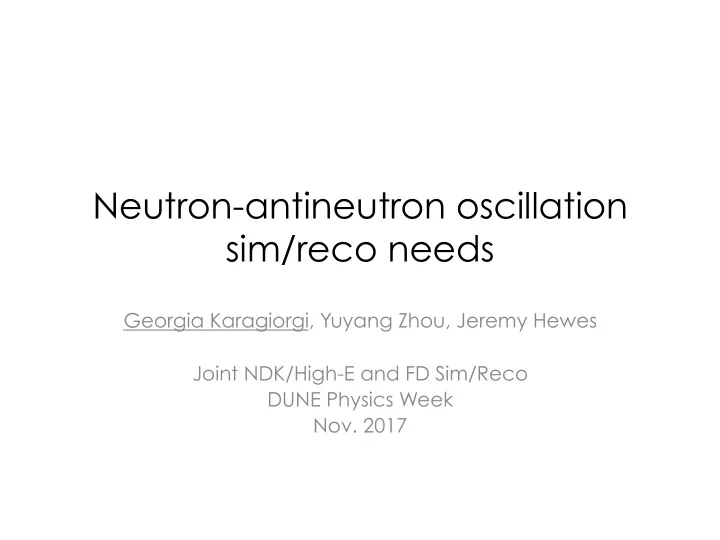

Neutron-antineutron oscillation sim/reco needs Georgia Karagiorgi, Yuyang Zhou, Jeremy Hewes Joint NDK/High-E and FD Sim/Reco DUNE Physics Week Nov. 2017
Neutron-antineutron oscillation in DUNE Search for rare, baryon-number violating signature. Anticipated background contributions from atmospheric neutrinos. Signature/topology is visually striking: “star event” à Use a trained CNN to differentiate n- nbar events from atmospheric neutrino events. For more details on analysis method, results, and current status, see yesterday’s talk by Yuyang Zhou: https://indico.fnal.gov/event/15181/session/2/contribution/11/material/ slides/0.pdf
Neutron-antineutron oscillation in DUNE e.g. CNN score cut Results: signal Network training results show excellent selection signal vs. background separation. background rejection Optimized score cut yields 14% signal efficiency and 99.997% background rejection efficiency à DUNE sensitivity is 5x better than the existing bound from Super-Kamiokande (leading world limit on this process). Systematic uncertainties: largely educated guesses based on Super-K search
Simulation needs Systematic uncertainty assumptions are in need of further work and studies to validate/ better quantify. Signal simulation uncertainties: nuclear suppression factor for bound-neutron oscillation • final state branching fractions and final state interactions within the nucleus • Background simulation uncertainties: atmospheric neutrino fluxes • neutrino cross-sections, including nuclear effects and final state interactions within • the nucleus Selection efficiency: ROI selection efficiency • finite statistics size of sample used for training and inference • backgrounds from other detector activity (e.g. cosmics) • Detector response: gain variation • field non-uniformity • electron lifetime • noise levels •
Simulation needs Systematic uncertainty assumptions are in need of further work and studies to validate/ better quantify. Signal simulation uncertainties: from theory; can quote bound lifetime nuclear suppression factor for bound-neutron oscillation • final state branching fractions and final state interactions within the nucleus • J. Barrow et al. Background simulation uncertainties: ~ well-characterized atmospheric neutrino fluxes • neutrino cross-sections, including nuclear effects and final state interactions within • ~ well-characterized the nucleus backgrounds from other detector activity (e.g. cosmics) • Selection efficiency: APA and ROI selection • finite statistics of samples used for training and inference • Detector response: gain variation • need dedicated studies field non-uniformity • à more event samples! electron lifetime • noise levels • data reduction scheme •
processing Reconstruction needs Very minimal reconstruction needs (we use recob::Wire after deconvolution • and before hit finding), and then apply APA/ROI selection and feed images to CNN. However, it might be useful to study different zero suppression/data reduction • schemes à deconvolution; and effects of different ROI selection (threshold based, after deconvolution). For each MC systematic variation, will need: ~200,000 n-nbar events and ~200,000 atmospheric neutrino events (for • inference) 4,000 jobs x 5,000 events/job, on grid, taking about 5,000 hrs per sample, and • 200-500 GB per sample For additional backgrounds studies, will need Cosmogenic simulations (10x expected data statistics?) •
Recommend
More recommend